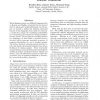108 search results - page 15 / 22 » Learning Tense Translation from Bilingual Corpora |
COLING
2000
13 years 9 months ago
2000
When aligning texts in very different languages such as Korean and English, structural features beyond word or phrase give useful intbrmation. In this paper, we present a method f...
ACL
2009
13 years 5 months ago
2009
We investigate the task of unsupervised constituency parsing from bilingual parallel corpora. Our goal is to use bilingual cues to learn improved parsing models for each language ...
ACL
2010
13 years 5 months ago
2010
Bilingual lexicons are fundamental resources. Modern automated lexicon generation methods usually require parallel corpora, which are not available for most language pairs. Lexico...
ACL
2010
13 years 5 months ago
2010
Lexicalized reordering models play a crucial role in phrase-based translation systems. They are usually learned from the word-aligned bilingual corpus by examining the reordering ...
LREC
2008
13 years 9 months ago
2008
Producing machine translation (MT) for the many minority languages in the world is a serious challenge. Minority languages typically have few resources for building MT systems. Fo...

